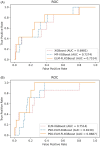An AI-driven machine learning approach identifies risk factors associated with 30-day mortality following total aortic arch replacement combined with stent elephant implantation
- PMID: 40742406
- PMCID: PMC12315218
- DOI: 10.1080/07853890.2025.2540018
An AI-driven machine learning approach identifies risk factors associated with 30-day mortality following total aortic arch replacement combined with stent elephant implantation
Abstract
Objectives: During emergency surgery, patients with acute type A aortic dissection (ATAAD) experience unfavourable outcomes throughout their hospital stay. The combination of total aortic arch replacement (TAR) and frozen elephant trunk (FET) implantation has become a dependable choice for surgical treatment. The objective of this research was to utilize a machine learning technique based on artificial intelligence to detect the factors that increase the risk of mortality within 30 days after surgery in patients who undergo TAR in combination with FET.
Methods: From January 2015 to December 2020, a total of 640 patients with ATAAD who underwent TAR and FET were included in this study. The subjects were divided into a test group and a validation group in a random manner, with a ratio of 7 to 3. The objective of our research was to create predictive models by employing different supervised machine learning techniques, such as XGBoost, logistic regression, support vector machine (SVM) and random forest (RF), to assess and compare their respective performances. Furthermore, we employed SHapley Additive exPlanation (SHAP) measures to allocate interpretive attributional values.
Results: Among all the patients, 37 (5.78%) experienced perioperative mortality. Subsequently, a total 50 of 10 highly associated variables were selected for model construction. By implementing the new method, the AUC value significantly improved from 0.6981 using the XGBoost model to 0.8687 with the PSO-ELM-FLXGBoost model.
Conclusion: In this study, machine learning methods were successfully established to predict ATAAD perioperative mortality, enabling the optimization of postoperative treatment strategies to minimize the postoperative complications following cardiac surgeries.
Keywords: Machine learning (ML); acute type A aortic dissection; mortality; prediction model; stent elephant implantation; total aortic arch replacement.
Conflict of interest statement
No potential conflict of interest was reported by the author(s).
Figures






Similar articles
-
Preoperative prediction of major adverse outcomes after total arch replacement in acute type A aortic dissection based on machine learning ensemble.Sci Rep. 2025 Jul 1;15(1):20930. doi: 10.1038/s41598-025-06936-4. Sci Rep. 2025. PMID: 40595056 Free PMC article.
-
Classification and outcomes of extended arch repair for acute Type A aortic dissection: a systematic review and meta-analysis.Interact Cardiovasc Thorac Surg. 2017 Mar 1;24(3):450-459. doi: 10.1093/icvts/ivw355. Interact Cardiovasc Thorac Surg. 2017. PMID: 28040765
-
Aortic remodeling, distal stent-graft induced new entry and endoleak following frozen elephant trunk: A systematic review and meta-analysis.J Card Surg. 2022 Nov;37(11):3848-3862. doi: 10.1111/jocs.16918. Epub 2022 Sep 7. J Card Surg. 2022. PMID: 36069163
-
Total Arch With Hybrid Frozen Elephant Trunk Versus Branched Stented Anastomosis Frozen Elephant Trunk Repair.Interdiscip Cardiovasc Thorac Surg. 2025 Jul 3;40(7):ivaf164. doi: 10.1093/icvts/ivaf164. Interdiscip Cardiovasc Thorac Surg. 2025. PMID: 40644331
-
Outcomes of Castor Single-Branched Stent Graft for Reconstruction of Multiple Supra-Aortic Branches in Aortic Arch Disease.J Endovasc Ther. 2025 Aug;32(4):1155-1164. doi: 10.1177/15266028231205411. Epub 2023 Oct 26. J Endovasc Ther. 2025. PMID: 37882172
References
-
- Conzelmann LO, Weigang E, Mehlhorn U, et al. Mortality in patients with acute aortic dissection type A: analysis of pre- and intraoperative risk factors from the German Registry for Acute Aortic Dissection Type A (GERAADA). Eur J Cardiothorac Surg. 2016;49(2):e44–e52. doi: 10.1093/ejcts/ezv356. - DOI - PubMed
MeSH terms
LinkOut - more resources
Full Text Sources
